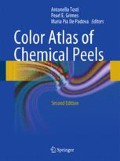Abstract
The author has extensive experience using the combination of salicylic acid and TCA 10–15% for facial peeling [1]. She has treated innumerable patients with moderate to severe melasma with this combination regimen. In the initial series of 27 patients, 9 were classified as Fitzpatrick skin type IV, 11 were skin type V, and 7 were skin type VI. Many of the subjects included in the pilot group of patients had not responded to salicylic acid or glycolic acid peels. The concentration of salicylic acid was 20% and 30%, and the TCA concentration was 10%. A series of four peels were performed at 2-week intervals. Thirty percent of the patients experienced moderate improvement, and 70% experienced significant improvement in hyperpigmentation. Sixteen percent had minimal to mild side effects, which cleared within 1 week. The results of the study suggested that the combination peel is safe and efficacious for treatment of moderate and severe melasma. The peel has since been used successfully in all skin types. Swinehart pretreated a series of patients with lentigines, pigmented keratoses, and actinic damage of the dorsal hands with TCA 20% prior to application of a 50% salicylic acid paste [2]. He reported excellent results.
Access this chapter
Tax calculation will be finalised at checkout
Purchases are for personal use only
References
Grimes PE, Rendon M, Pallerano J (2008) Superficial chemical peels in aesthetics & cosmetic surgery in darker skin types. Lippincott Williams & Wilkins, Philadelphia, pp 155–169
Swinehart JM (1992) Salicylic acid ointment peeling of the hands and forearms. Effective nonsurgical removal of pigmented lesions and actinic damage. J Dermatol Surg Oncol 18(6):495–498
Lazo ND, Meine JG, Downing DT (1995) Lipids are covalently attached to rigid corneocyte protein envelope existing predominantly as beta-sheets: a solid state nuclear magnetic resonance study. J Invest Dermatol 105:296–300
Imayama S, Ueda S, Isoda M (2000) Histologic changes in the skin of hairless mice following peeling with salicylic acid. Arch Dermatol 136:1390–1395
Matarasso SL, Glogau RG (1991) Chemical face peels. Dermatol Clin 9:131–150
Rajalingam D, Loftis C, Xu JJ, Kumar TK (2009) Trichloroacetic acid induced protein precipitation involves the reversible association of a stable partially structured intermediate. Protein Sci 18:980–993
Bridenstine JB, Dolezal JF (1994) Standardizing chemical peel solution formulations to avoid mishaps. Great fluctuations in actual concentrations of trichloroacetic acid. J Dermatol Surg Oncol 20(12):813–816
Nguyen TH, Rooney JA (2000) Trichloroacetic acid peels. Dermatol Ther 13:173–192
Rubin MG (1995) Manual of chemical peels: superficial and medium depth. J.B. Lippincott Company, Philadelphia, pp 79–88
Brody HJ (1997) Chemical peeling and resurfacing, 2nd edn. Mosby, St. Louis
Disclaimer
The author has no financial interest in any of the products or equipment mentioned in this chapter.
Author information
Authors and Affiliations
Corresponding author
Editor information
Editors and Affiliations
Rights and permissions
Copyright information
© 2011 Springer-Verlag Berlin Heidelberg
About this chapter
Cite this chapter
Grimes, P.E. (2011). Combination Salicylic Acid/TCA Chemical Peeling. In: Tosti, A., Grimes, P., De Padova, M. (eds) Color Atlas of Chemical Peels. Springer, Berlin, Heidelberg. https://doi.org/10.1007/978-3-642-20270-4_8
Download citation
DOI: https://doi.org/10.1007/978-3-642-20270-4_8
Published:
Publisher Name: Springer, Berlin, Heidelberg
Print ISBN: 978-3-642-20269-8
Online ISBN: 978-3-642-20270-4
eBook Packages: MedicineMedicine (R0)

